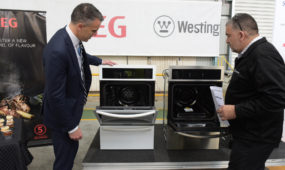Resin firing system leads way in strata control
Manufacturing
A SYSTEM to stop mines from caving in will be used to safeguard new projects in Mongolia.

Sign up to receive notifications about new stories in this category.
Thank you for subscribing to story notifications.
The Trajectaflex Resin Firing System was developed by Wilco Technologies in South Australia and is a highly-effective resin capsule installation tool.
Resin bolts have become an increasingly popular strata control technique that incorporates the use of a chemical adhesive to anchor steel studs into mine walls or ceilings.
The Trajectaflex system centres around a steel nozzle that increases the efficiency and safety of resin set bolting cycles.
The innovation has been used at a number of mines across Australia and at the Grasberg mine in Indonesia, which is the largest gold mine and the third largest copper mine in the world.
Wilco is based in Kimba on Eyre Peninsula, about 480km northwest of South Australia’s capital Adelaide.
It has recently sent two of its resin-firing systems to the Oyu Tolgoi mine in Mongolia.
Oyu Tolgoi is one of the largest copper mines in the world, with the majority of the value buried more than a kilometre underground.
Wilco CFO Clare Williams said the patented nozzle gave operators the ability to index the bolt hole effectively to install the resin capsules.
“Obviously in underground mines strata control is critical so jumbo operators install the resin bolts and each bolt can hold up to 25t of rock,” she said.
“The Trajectaflex is a one-man system with less operator movement on and off the jumbo platform, which reduces fatigue and the chance of injury.
“It eliminates the need for an offsider and makes it easier to load the resin capsules.”
The Trajectaflex resin-firing nozzle is a single-pass system that consists of a tension spring with an adapter at each end. It also includes a nylon inner tube and an exchangeable tip.
The 800mm nozzle is set at the end of a rail on a dual boom jumbo, mounted onto an independent slide.
This enables operators to drill the hole with one boom while the other boom inserts the resin and the bolt. Each boom can be extended and shortened to make the installation easier.
“The spring is the key. If the jumbo operator is trying to insert the resin capsules into a 35mm pre-drilled hole that is four to eight metres away from them, they can flex the spring, which will self-index the nozzle tip into the bolt hole,” Claire said.
“Then with air pressure the operator can shoot the resin capsules into the hole they drilled and then insert the bolt.”
The hole can be probed for without damage to the nozzle and there is no need to physically check for correct bolt hole alignment.
This process saves operators up to 40 minutes during bolting cycles compared with the amount of time it takes to insert plastic tubes that are commonly used.
Wilco has also been contacted by a number of mines in South America and is aiming to have the Trajectaflex system in use there from next year.
Wilco is a family-run company established in 2005 by husband and wife team Michael and Clare Williams.
Michael previously worked as a jumbo operator at Olympic Dam for 18 years but left the job to take up farming again.
However, South Australia’s often difficult farming conditions and the crippling Millennium Drought made it difficult to generate a steady income.
That is when Michael came up with the idea for the Trajectaflex system and trialled it at Olympic Dam, where it is still in use.
Olympic Dam is located about 560 km north of South Australia’s capital Adelaide, and is the world’s fourth largest copper resource.
Jump to next article



